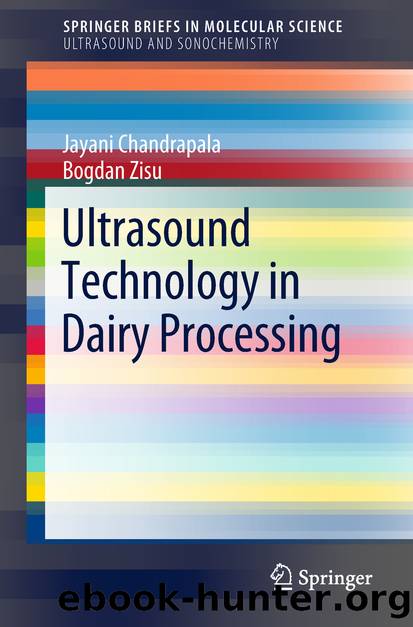Ultrasound Technology in Dairy Processing by Jayani Chandrapala & Bogdan Zisu

Author:Jayani Chandrapala & Bogdan Zisu
Language: eng
Format: epub
ISBN: 9783319934822
Publisher: Springer International Publishing
Chandrapala et al. (2012b) conducted a detailed investigation of the protein aggregation mechanism with and without an ultrasound step prior secondary heating. The surface charge which is indicative of electrostatic interactions and reactive thiol groups, which are indicative of thiol–disulfide interactions remained unchanged after sonication in between the preheating and post-heating steps (Fig. 1.8b). However, the surface hydrophobicity of these aggregates which is indicative of hydrophobic interactions was altered (Fig. 1.8b). It was concluded that physical forces generated through acoustic cavitation broke down the protein aggregates, leading to the formation of smaller aggregates with a lower surface hydrophobicity. The newly formed smaller aggregates with low surface hydrophobicities are resistant towards further aggregation during post-heating. This, in turn, improves the heat stability. Shen et al. (2017) investigated the physico-chemical properties of thermally aggregated whey proteins as affected by high-intensity ultrasound (20 kHz, 31 Wcm−2) prior to and after a preheat treatment (85 °C/30 min) process. They showed a significant increase in surface hydrophobicity and free thiols without affecting the total thiol content. They hypothesized that the disruption of more non-covalent interactions as opposed to disulphide bonds was accountable for the observed effects.
Yanjun et al. (2014) suggested that the sonication-induced changes of whey protein solutions at a frequency of 20 kHz were mostly macromolecular level physical modifications without protein structural changes. Similarly, Frydenberg et al. (2016a, b) investigated the effect of thermosonication (24 kHz, 300 Wcm−2) on the secondary structure of WPI samples with varying α-LA and β-LG ratios as a function of pH. Thermosonication-reduced enthalpy of whey protein denaturation with greater reductions at higher pH. The protein structure loosens when pH moves away from the isoelectric point as the surface charge density increases and repulsive forces are higher. However, no secondary structural changes were observed. They hypothesized that the high pressure generated by acoustic cavitation induces an open protein state where water easily permeates. This, in turn, replaces the intramolecular hydrogen bonds with water–protein hydrogen bonds and the strong water–protein hydrogen bonds then lead to an intact secondary protein structure. Similarly, Chandrapala et al. (2011) showed no substantial protein structural changes with up to 60 min sonication of WPC solutions at 31 W. In contrast, Kresic et al. (2008) investigated the rheological and thermophysical properties of WPC and WPI solutions subjected to sonication (20 kHz, 15 min). They attributed the observed flow behaviour changes to an altered protein structure. It was hypothesized that the hydrophilic amino acid segments of the proteins are exposed with sonication leading to an increased binding of water molecules. Similarly, Stathopulos et al. (2004) showed amyloid fibril formation with sonication (20 kHz, 30 W) of BSA protein solutions. However, this study used excessively high ultrasonic energy and small sample volumes.
Martini and Walsh (2012) treated whey solutions containing 28.2% total solids with US (15 W, 5 min, 60 °C) and investigated the thermal stability and sensory evaluation. Interestingly, no significant changes in sensory attributes were observed. Moreover, several unfavourable attributes such as cardboard and malty were less prominent in sonicated samples.
Download
This site does not store any files on its server. We only index and link to content provided by other sites. Please contact the content providers to delete copyright contents if any and email us, we'll remove relevant links or contents immediately.
| Automotive | Engineering |
| Transportation |
Whiskies Galore by Ian Buxton(41533)
Introduction to Aircraft Design (Cambridge Aerospace Series) by John P. Fielding(32890)
Small Unmanned Fixed-wing Aircraft Design by Andrew J. Keane Andras Sobester James P. Scanlan & András Sóbester & James P. Scanlan(32575)
Craft Beer for the Homebrewer by Michael Agnew(17935)
Turbulence by E. J. Noyes(7702)
The Complete Stick Figure Physics Tutorials by Allen Sarah(7143)
Kaplan MCAT General Chemistry Review by Kaplan(6601)
The Thirst by Nesbo Jo(6440)
Bad Blood by John Carreyrou(6278)
Modelling of Convective Heat and Mass Transfer in Rotating Flows by Igor V. Shevchuk(6226)
Learning SQL by Alan Beaulieu(6038)
Weapons of Math Destruction by Cathy O'Neil(5833)
Man-made Catastrophes and Risk Information Concealment by Dmitry Chernov & Didier Sornette(5652)
Digital Minimalism by Cal Newport;(5394)
Life 3.0: Being Human in the Age of Artificial Intelligence by Tegmark Max(5190)
iGen by Jean M. Twenge(5163)
Secrets of Antigravity Propulsion: Tesla, UFOs, and Classified Aerospace Technology by Ph.D. Paul A. Laviolette(4996)
Design of Trajectory Optimization Approach for Space Maneuver Vehicle Skip Entry Problems by Runqi Chai & Al Savvaris & Antonios Tsourdos & Senchun Chai(4843)
Electronic Devices & Circuits by Jacob Millman & Christos C. Halkias(4750)
